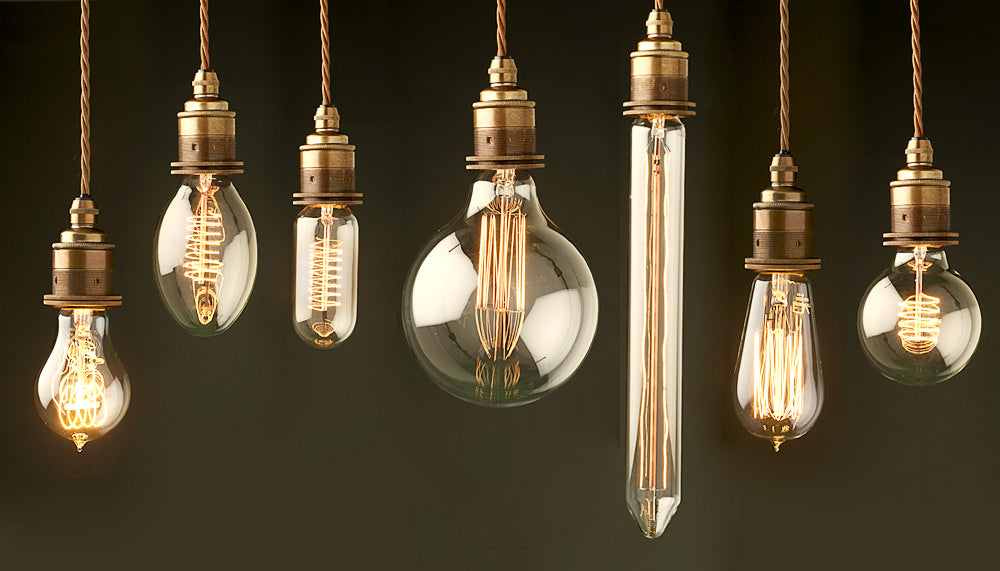Differences Between Edison Bulbs, Antique Light Bulbs, LED Filament Bulbs - How to choose from?
Antique lights, or Edison Bulbs, have recently become incredibly popular. You can find these cool looking bulbs everywhere, from your favorite restaurant to DIY steampunk lamps and costumes. However, in the midst of this new found lighting love, some are becoming disappointed by the amount of brightness emitted from these beautiful bulbs. Before you decide to invest in a few Edison bulbs, you may want to get a better understanding of what you’re getting for your wattage.
Today’s standard incandescent light bulbs have a pear shape, an average wattage between 40 and 150 Watts, and typically last around 1000 hours. Though standard incandescents are being phased out by more energy-efficient lighting such as LEDs, antique lighting is gaining popularity due to its creative vintage style. However, many people don’t realize that when they choose to use incandescent Edison bulbs in place of regular incandescent bulbs, they are losing some valuable luminosity—the brightness of Edison bulbs is actually lower than standard A19 incandescent lights.
Antique Light Bulbs

Most people don’t realize that watts are not the same as Lumens, aka brightness. Antique lighting does not have the same level of brightness, or the same Lumens per watt ratio, as standard incandescent lighting. Antique lighting is also typically lower in color temperature than today’s incandescents, meaning they are less than 2700 Kelvin, the standard for incandescent lamps. Vintage bulbs range between 1800-2400 Kelvin, producing a more orange light as opposed to the soft yellow glow emitted by incandescents. This is further exacerbated by the amber tint characteristically given to the glass of an antique bulb. You can think of the light from an antique bulb as being similar to the color of a flame, or sunrise/sunset.
So, when purchasing antique bulbs for your home, be aware that a 60-Watt antique bulb will emit closer to 400 Lumens, whereas a 60-Watt standard A19 incandescent bulb will emit closer to 800 Lumens. But remember, these bulbs are for accent lighting, not task lights or to replace overhead lights. Before installing an antique light with a higher wattage, check your fixture’s wattage rating to make sure it can handle the additional watts.
LED Filament Bulbs

What if you really enjoy the look of these bulbs but want longer-lasting lights? Consider trying LED filament bulbs. LED filament bulbs use traditional-aesthetic components of vintage and standard incandescent lighting, such as shape and traditional glass shielded circuits. However, the LED emitters within the bulbs last for a longer period of time than the fragile incandescent filaments. With these lights you still get the vintage look of Edison light bulbs, but instead of only having about 1000 Lumen-hours, LED filament bulbs have approximately 15,000 life hours. However, this is much shorter than the average Lumen life of regular LED bulbs which typically last around 50,000 hours on average. This has to do with the type of LEDs being used in the filament bulbs along with fragileness and the possibility of overheating.
While LED filament bulbs contain a lower wattage, you should still check the Lumens. With LED filament bulbs you get the same color temperature, so the effect is identical to traditional lamps–however, you won’t have to worry about a fragile filament or high energy cost. This warmer light in vintage inspired glass creates a softer glow, similar to that emitted by standard incandescents.
EP LIGHT Bulbs

Swirling with vivid color in abstract designs, this unique work of art by EP Lights provides stunning ambient illumination and creative style to any modern decor. Each bulb is individually handcrafted with eco-friendly, drop-resistant resin that’s crystal clear and never hot to the touch. No matter where you display it, this rich, radiant art piece makes a bold, artistic statement that effortlessly enhances the atmosphere of your space.
Whether you decide to invest in LED or incandescent antique-style lighting it is important to weigh your options. With LED filament bulbs you will get more Lumen life and a warmer color temperature, whereas with incandescent antique lights you may have a few more bulb style options, but a shorter lifespan. What have your experiences been with antique light bulbs? You can also see what other people are saying about these bulbs by checking out the fantastic reviews.


POST COMMENTS
This article does a wonderful job explaining the differences between Edison bulbs, antique light bulbs, and LED filament bulbs! It’s fascinating to see how each type offers a unique aesthetic and functionality, especially as LED technology has evolved to replicate the warm, nostalgic glow of traditional bulbs. I appreciate the breakdown of each option’s energy efficiency and longevity—important considerations for anyone looking to balance style with practicality in their lighting choices. Your guide makes it much easier to choose the right bulb for various settings, whether it’s for ambiance or energy savings.
One question I have: with LED filament bulbs becoming more popular, are there specific dimmer switches or electrical adjustments needed to ensure they perform optimally? It would be great to know if there are any compatibility concerns to keep in mind!
I’m from sri Lanka. I need to price of A19 bulb with holders B type, if I got about 50 bulbs.